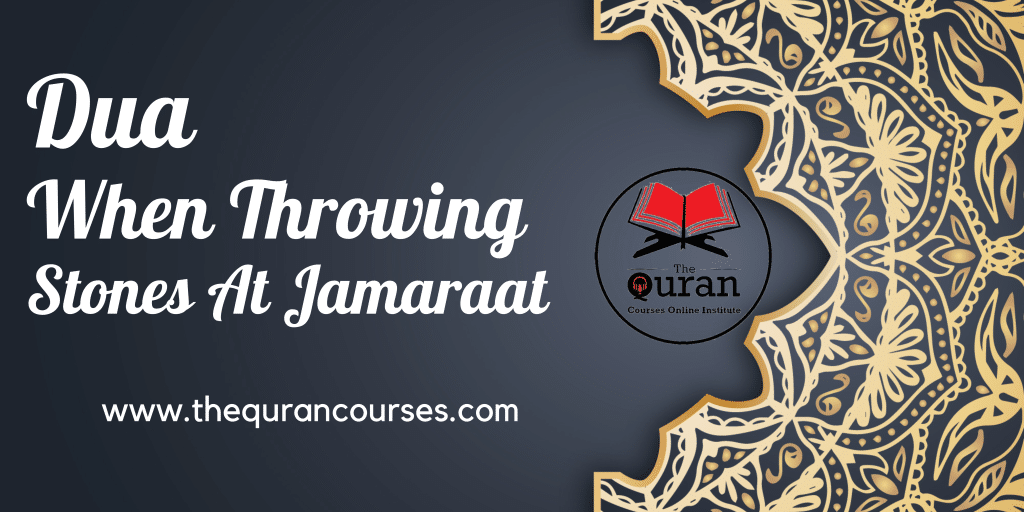Dua When Throwing Stones At Jamaraat In Arabic
اللهُ أكْبَر
Dua When Throwing Stones At Jamaraat In English Transcription
Allaahu ‘Akbar
Dua When Throwing Stones At Jamaraat In English
Allah is the Greatest!
Al-Bukhari:1751,1752,1753
Stoning of the devil
From Wikipedia, the free encyclopedia
Go to navigation to search”Ramy” and redirect here. For the television series Hulu, see Ramy (TV series).
Stoning of the devil of 1942
The stoning of the devil (Arabic: رمي الجمرات Ramy al-jamarāt, lit. “Throwing of the jamarāt [place of pebbles]”) [1] [2] [3] is part of the annual pilgrimage of the Islamic Hajj to the holy city of Mecca in Saudi Arabia. During the ritual, Muslim pilgrims throw pebbles on three walls (formerly pillars), called jamarāt, in the city of Mina, just east of Mecca. This is one of a series of ritual acts that must be performed in the Hajj. It is a symbolic reconstruction of Abraham’s hajj, where he stoned three pillars representing the temptation to disobey God and preserve Ishmael.
During Eid al-Adha (the tenth day of the month of Dhu al-Hijjah), pilgrims must hit one of the three jamraat (Big Jamaraat or Al-Jamrah Al-Aqaba) with seven pebbles. Once stoning is finished on Eid, each pilgrim must cut or shave his hair [4]. During each of the next two days, they must hit each of the three walls with seven pebbles, going in order from east to west.
It takes at least 49 pebbles for the ritual, or more if some misses are missing. Some pilgrims stay in Mina for one more day, in which case they must stone each wall seven times. The stones used in stoning are traditionally collected in Muzdalifah, a plain south-east of Mina, the night before the first pitch, but can also be collected in Mina.
contents
1 replacement of the pillars
2 Historical and spiritual significance
3 incidents
4 See also
5 references
Replacement of pillars
Until 2004, the three jamarāt (singular: jamrah) were high pillars. After the Hajj of 2004, the Saudi authorities replaced the pillars with walls 26 meters long for security. many people accidentally threw pebbles at people on the other side. To allow easier access to the jamarāt, a single-level pedestrian bridge called Jamaraat Bridge was built around them, allowing pilgrims to throw stones from the ground or from the bridge.
The jamarāt are named (from the east):
the first jamrah (al-jamrah al-‘ūlā), or the smallest jamrah (الجمرة الصغرى al-jamrah aṣ-ṣughrā),
the middle jamrah (الجمرة الوسطى al-jamrah al-wusṭā),
the biggest jamrah (الجمرة الكبرى al-jamrah al-kubrā) or Jamrah of Aqaba (جمرة العقبة jamrat al-āqaba).
Prior to 2004, the distance between the small and medium jamarāt was 150 m (490 ft); between the middle and wide jamarāt, it was 225 m [5].
The historical and spiritual significance
The ritual reconstructs the pilgrimage of Abraham (Ibrāhīm) to Mecca, as explained by the Muslim historian al-Azraqi:
When he [Abraham] left Mina and was brought back to Al-Aqaba (the called parade), the devil appeared to him at Stone-Tas of the Defile. Gabriel (Jibril) said to him, “Shovel him!” so Abraham threw him seven stones and disappeared.
Then he appeared to him at Middle Stone-Heap. Gabriel said to him, “Shovel him!” so he gave him seven stones to make him disappear from him. Then he appeared to him at the little pile of stone. Gabriel said to him, “Shovel him!” then he gave him seven stones like little stones to throw with a slingshot. Then the devil withdrew from him. [6]
The three jamarāt represent the devil: the first and the greatest represent his temptation of Abraham against the sacrifice of Ishmael (Ismā’īl); the second represents the temptation of Abraham’s wife, Hagar (Hajar), to incite him to arrest him; the third represents his temptation for Ishmael to avoid being sacrificed. He was reprimanded each time and the throwing of the stones symbolizes these reprimands.
The stoning of the jamarāt also represents the repudiation of the self of man (an-nafs al-‘amāra, literally the “internal despot”) and the setting aside of his desires and desires lowest. As an Islamic theologian says:
If al-nafs al-‘amāra can be crushed during the stoning of Jamrat al-‘Aqaba (the Jamrah of Aqaba), one has to go to the next step to get closer to Allah, and between servant and Allah, there is no more than the distance of a step, if we have been able to cross this step and exceed it beyond its desires and desires, then the following is the degree of proximity with Allah.
During the two or three days following Eid in Mina, the three jamarāt must be stoned, which means that one must trample on his internal despot (an-nafs al-‘amāra), the external despot of the shaitan. jinns. (Iblīs and his ilk), and Shayana among humans (enemies of religion and humanity).
The stoning of the three jamarāt consists essentially of trampling the despots and waging them at war. When we focus on them and hate them, then we automatically focus with complete attention on ourselves – and rightly – by stoning the jamarāt, we must focus entirely on ourselves. It is an attack on one’s inner temptations or basic desires, and signals one’s distance from oneself and increased submission to Allah’s will. [7]
incidents
Main article: Incidents during Hajj
The ritual stoning of the devil is considered the most dangerous part of the pilgrimage, as sudden movements of the crowd on or near the Jamaraat bridge can cause crushing. On several occasions, thousands of participants were asphyxiated or trampled to death in the stampedes.
An important step in crowd management is the recent replacement of jamarāt pillars with walls to facilitate and speed stoning. The bridge has also been expanded in recent years to accommodate the ever-increasing number of pilgrims who make the pilgrimage each year.
The crowd is particularly difficult on the last day of the Hajj, the day the pilgrims leave the Mina Valley and return to Mecca for the last farewell, the Tawaf (the final circumambulation of the Kaaba).
According to a hadith, the last stoning of Muhammad took place just after the noon prayer. Many scholars believe that the ritual can be performed at any time between noon and sunset that day; However, many Muslims learn that this should be done immediately after the midday prayer. This leads people to camp until noon and rush to stoning.
These two factors are believed to be the main culprits in a 2006 Hajj stampede, which killed at least 346 pilgrims and injured at least 289 more. This is despite repeated attempts by the authorities to inform the pilgrims of the possibility of staging their visit to the jamarāt and to ask them to leave their luggage in their tent.
The lack of cooperation of the pilgrims who do not leave the jamarāt area by the route taken and which therefore impede the movements of the other arrivals is an additional confounding factor in the tragedy.
A new crush occurred on September 24, 2015 in Mina, at least 2,411 pilgrims were killed, according to a new count by the Associated Press, three times more deaths than the kingdom three months later [8].
AP figures show that the September 24 crush in Mina is the deadliest in the history of the annual pilgrimage. This happened just a few weeks after the fatal collapse of a crane in Mecca.
Authorities have said that the rush and the rout of Mina occurred when two waves of pilgrims converged on a narrow road, choking or trampling on people caught in the disaster. [8]
Saudi Arabia has spent billions of dollars for crowd control and security measures for people attending the annual five-day pilgrimage, required of all valid Muslims once in their lifetime, but the impressive number of participants makes their security difficult. The 2015 hajj has attracted some two million pilgrims, although in recent years it has attracted more than three million without any major incidents.
However, the experts said that the density of the crowd was likely to lead to a collapse of the crowd under such circumstances. Edwin Galea, from the University of Greenwich, said, “If you are designing an event to handle this crowding, this is inherently dangerous.”
He pointed out that the 500,000 people per hour that can cross the Jamarat Bridge after enlargement in 2004 equates to the biggest football crowd of all time once every 24 minutes or to the German population in a week. One possible solution would be to extend Hajj over a longer period. [9]



